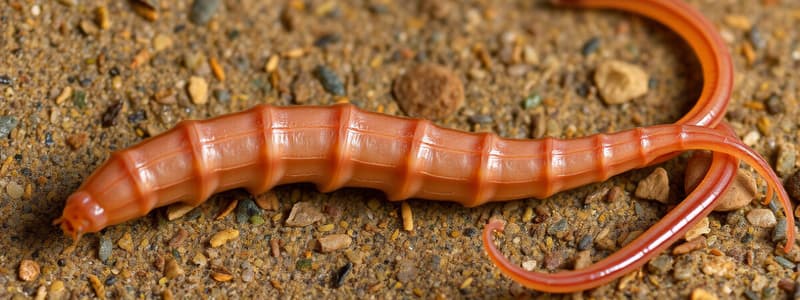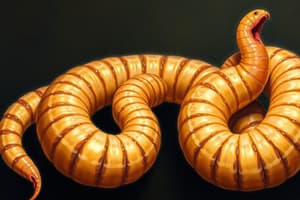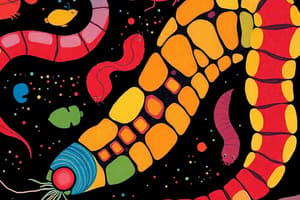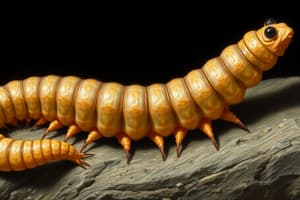Podcast
Questions and Answers
What defines all helminths in terms of their relationship with host organisms?
What defines all helminths in terms of their relationship with host organisms?
- They are free-living organisms.
- They rely on a host organism and harm it. (correct)
- They have no specialized organs for digestion.
- They reproduce asexually.
Which of the following correctly describes the body structure of nematodes?
Which of the following correctly describes the body structure of nematodes?
- They are segmented flatworms.
- They lack a defined digestive tract.
- They have a tube-within-a-tube body design. (correct)
- They form proglottids for reproduction.
What specialized attachment feature do cestodes possess?
What specialized attachment feature do cestodes possess?
- An elytra for attachment.
- Extensive branching tentacles.
- A large dorsal fin.
- A scolex with hooks and suckers. (correct)
What is a common characteristic of trematodes?
What is a common characteristic of trematodes?
How do cestodes obtain nutrients?
How do cestodes obtain nutrients?
In the lifecycle of helminths, what typically occurs after the adult female worm releases an egg?
In the lifecycle of helminths, what typically occurs after the adult female worm releases an egg?
What distinguishes nematodes from other helminth groups?
What distinguishes nematodes from other helminth groups?
Which statement is true about the reproductive strategy of helminths?
Which statement is true about the reproductive strategy of helminths?
What common feature do all helminths share?
What common feature do all helminths share?
What adaptation helps nematodes to effectively attach to their host?
What adaptation helps nematodes to effectively attach to their host?
Match the following helminth groups with their descriptions:
Match the following helminth groups with their descriptions:
Match the following helminth characteristics with their respective groups:
Match the following helminth characteristics with their respective groups:
Match the following helminth types with their common name:
Match the following helminth types with their common name:
Match the following features with the respective group of helminths:
Match the following features with the respective group of helminths:
Match the following statements about the helminth groups:
Match the following statements about the helminth groups:
Match the helminth group with their nutritional acquisition method:
Match the helminth group with their nutritional acquisition method:
Match the following characteristics with the correct helminth group:
Match the following characteristics with the correct helminth group:
Match the following lifecycle terms with their meanings:
Match the following lifecycle terms with their meanings:
Match the following helminth groups with their primary characteristics:
Match the following helminth groups with their primary characteristics:
Match the following helminth groups with their common names:
Match the following helminth groups with their common names:
Match the following features to their corresponding helminth group:
Match the following features to their corresponding helminth group:
Match the following characteristics with the correct helminth group:
Match the following characteristics with the correct helminth group:
Match the following helminth groups with their reproduction methods:
Match the following helminth groups with their reproduction methods:
Match the following groups to their habitat:
Match the following groups to their habitat:
Match the following terms related to helminths with their definitions:
Match the following terms related to helminths with their definitions:
Match the following helminth types with their specific features:
Match the following helminth types with their specific features:
Helminths are classified only into two groups: nematodes and trematodes.
Helminths are classified only into two groups: nematodes and trematodes.
Cestodes possess a true digestive tract for nutrient absorption.
Cestodes possess a true digestive tract for nutrient absorption.
Nematodes are roundworms that have a tube-within-a-tube body design.
Nematodes are roundworms that have a tube-within-a-tube body design.
Trematodes are segmented worms that can be several meters long.
Trematodes are segmented worms that can be several meters long.
Adult helminths can reproduce asexually but primarily reproduce sexually.
Adult helminths can reproduce asexually but primarily reproduce sexually.
All helminths are parasitic and cause harm to their host organisms.
All helminths are parasitic and cause harm to their host organisms.
The scolex of a cestode is responsible for nutrient absorption.
The scolex of a cestode is responsible for nutrient absorption.
Nematodes have hooks and spines to aid in attachment to their hosts.
Nematodes have hooks and spines to aid in attachment to their hosts.
A common feature of trematodes is that they have simple lifecycles with only one host.
A common feature of trematodes is that they have simple lifecycles with only one host.
Helminths belong to the domain of prokaryotes.
Helminths belong to the domain of prokaryotes.
Flashcards are hidden until you start studying
Study Notes
Helminth General Characteristics
- Helminths are parasitic worms classified within the Kingdom Animalia, making them eukaryotes closely related to humans.
- They are motile chemoheterotrophs, meaning they obtain energy and nutrients from organic sources.
- Helminths reproduce sexually and possess specialized organs for digestion and self-protection.
- Their lifecycle typically involves an adult female releasing eggs that develop into larvae and then mature into adults.
- All helminths are inherently parasitic, relying on host organisms and causing harm to them.
Categories of Helminths
- Helminths are categorized based on their body structure into three main groups.
Nematodes
- Nematodes, or roundworms, have a tube-within-a-tube body design similar to humans.
- They possess a mouth connected to a complete digestive tract at one end and an anus at the other.
- Their mouths are equipped with hooks and spines for attachment to their host.
- Example: Adult hookworms infesting the intestines of dogs.
Cestodes
- Cestodes, or tapeworms, are segmented flatworms that can grow to several meters in length.
- They have a structure called a scolex, featuring hooks and suckers for attaching to their host.
- Cestodes lack a true digestive tract; instead, they absorb nutrients through their cuticle while living in the host's intestine.
Trematodes
- Trematodes, commonly referred to as flukes, are non-segmented flatworms often resembling small oval leaves.
- They possess a sucking mouthpart for attachment to hosts.
- Many trematodes have complex lifecycles involving multiple hosts and stages, indicating their adaptability and evolutionary complexity.
Helminth General Characteristics
- Helminths are parasitic worms classified within the Kingdom Animalia, making them eukaryotes closely related to humans.
- They are motile chemoheterotrophs, meaning they obtain energy and nutrients from organic sources.
- Helminths reproduce sexually and possess specialized organs for digestion and self-protection.
- Their lifecycle typically involves an adult female releasing eggs that develop into larvae and then mature into adults.
- All helminths are inherently parasitic, relying on host organisms and causing harm to them.
Categories of Helminths
- Helminths are categorized based on their body structure into three main groups.
Nematodes
- Nematodes, or roundworms, have a tube-within-a-tube body design similar to humans.
- They possess a mouth connected to a complete digestive tract at one end and an anus at the other.
- Their mouths are equipped with hooks and spines for attachment to their host.
- Example: Adult hookworms infesting the intestines of dogs.
Cestodes
- Cestodes, or tapeworms, are segmented flatworms that can grow to several meters in length.
- They have a structure called a scolex, featuring hooks and suckers for attaching to their host.
- Cestodes lack a true digestive tract; instead, they absorb nutrients through their cuticle while living in the host's intestine.
Trematodes
- Trematodes, commonly referred to as flukes, are non-segmented flatworms often resembling small oval leaves.
- They possess a sucking mouthpart for attachment to hosts.
- Many trematodes have complex lifecycles involving multiple hosts and stages, indicating their adaptability and evolutionary complexity.
Helminth General Characteristics
- Helminths are parasitic worms classified within the Kingdom Animalia, making them eukaryotes closely related to humans.
- They are motile chemoheterotrophs, meaning they obtain energy and nutrients from organic sources.
- Helminths reproduce sexually and possess specialized organs for digestion and self-protection.
- Their lifecycle typically involves an adult female releasing eggs that develop into larvae and then mature into adults.
- All helminths are inherently parasitic, relying on host organisms and causing harm to them.
Categories of Helminths
- Helminths are categorized based on their body structure into three main groups.
Nematodes
- Nematodes, or roundworms, have a tube-within-a-tube body design similar to humans.
- They possess a mouth connected to a complete digestive tract at one end and an anus at the other.
- Their mouths are equipped with hooks and spines for attachment to their host.
- Example: Adult hookworms infesting the intestines of dogs.
Cestodes
- Cestodes, or tapeworms, are segmented flatworms that can grow to several meters in length.
- They have a structure called a scolex, featuring hooks and suckers for attaching to their host.
- Cestodes lack a true digestive tract; instead, they absorb nutrients through their cuticle while living in the host's intestine.
Trematodes
- Trematodes, commonly referred to as flukes, are non-segmented flatworms often resembling small oval leaves.
- They possess a sucking mouthpart for attachment to hosts.
- Many trematodes have complex lifecycles involving multiple hosts and stages, indicating their adaptability and evolutionary complexity.
Helminth General Characteristics
- Helminths are parasitic worms classified within the Kingdom Animalia, making them eukaryotes closely related to humans.
- They are motile chemoheterotrophs, meaning they obtain energy and nutrients from organic sources.
- Helminths reproduce sexually and possess specialized organs for digestion and self-protection.
- Their lifecycle typically involves an adult female releasing eggs that develop into larvae and then mature into adults.
- All helminths are inherently parasitic, relying on host organisms and causing harm to them.
Categories of Helminths
- Helminths are categorized based on their body structure into three main groups.
Nematodes
- Nematodes, or roundworms, have a tube-within-a-tube body design similar to humans.
- They possess a mouth connected to a complete digestive tract at one end and an anus at the other.
- Their mouths are equipped with hooks and spines for attachment to their host.
- Example: Adult hookworms infesting the intestines of dogs.
Cestodes
- Cestodes, or tapeworms, are segmented flatworms that can grow to several meters in length.
- They have a structure called a scolex, featuring hooks and suckers for attaching to their host.
- Cestodes lack a true digestive tract; instead, they absorb nutrients through their cuticle while living in the host's intestine.
Trematodes
- Trematodes, commonly referred to as flukes, are non-segmented flatworms often resembling small oval leaves.
- They possess a sucking mouthpart for attachment to hosts.
- Many trematodes have complex lifecycles involving multiple hosts and stages, indicating their adaptability and evolutionary complexity.
Studying That Suits You
Use AI to generate personalized quizzes and flashcards to suit your learning preferences.




